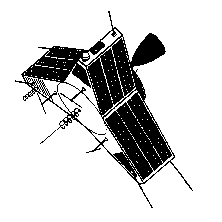 AMSAT-OSCAR
10
AMSAT-OSCAR
10
 AMSAT-OSCAR
10
AMSAT-OSCAR
10
 Satellite
Summary
Satellite
SummaryBeacons:
 Description
DescriptionThe following is an informative note from Peter, DB2OS:
Satellite operators frequently ask "what is the attitude of Oscar-10", or "can I have ALON/ALAT values for my computer program." Here's the analysis written by James Miller, G3RUH.The onboard computer of AMSAT-OSCAR 10 failed due to radiation damage of the memory chips. Since then we have had no more attitude control and due to seasonal changes of the alignment of the Sun in respect to the solar panels, there are times were no electrical power will be available and the spacecraft goes into hibernation until the sunangle is better again. The battery is indeed fully depleted and due to the harsh environment it may already have lost its capability to store electrical energy.
If the electrical power from the solar array is getting marginal, the transponders starts FMing,which means that your carrier is moving back and forth in frequency depending on the current transponder load. During those "undervoltage conditions," it sometimes happens that the onboard computer (IHU) starts to execute random code from the memory, which might turn transponders or beacons randomly on/off. The beacon may even sound like OSCAR-13, but that's mainly because the 400 Bit/s BPSK is done by hardware; indeed it contains no useful information. Under normal circumstances the transponder is on and the general beacon is transmitting only an unmodulated carrier.
See also W4SM's AO-10 Update for the latest.
 References
References
Last update May 31, 2003 - N7HPR